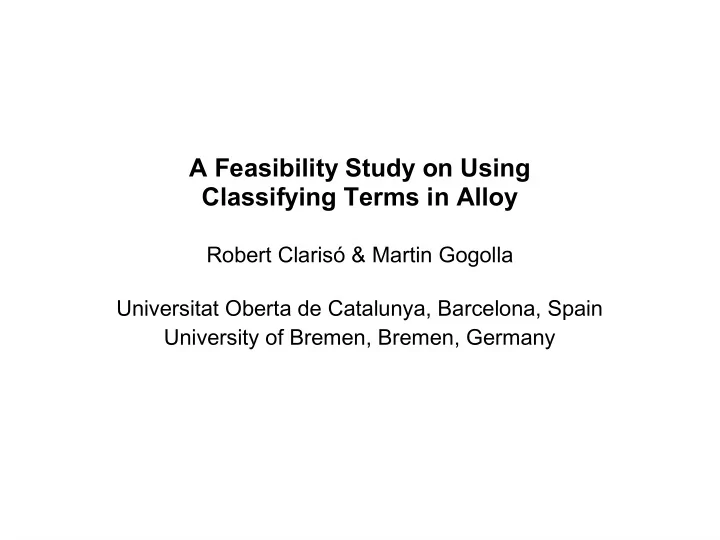

A Feasibility Study on Using Classifying Terms in Alloy Robert Clarisó & Martin Gogolla Universitat Oberta de Catalunya, Barcelona, Spain University of Bremen, Bremen, Germany
Motivation and Overview on Approach ● Fundamental problem for class model / conceptual schema is satisfiability: finding an instantiation (object diagram) populating the model and fulfilling integrity constraints ● Model finders: finding such instantiations; output of model finder used for validation (instantiations as [counter-] examples); for testing purposes (instantiations as test cases); outputs should be diverse: representing wide range of scenarios and situations ● Premise here: classifying terms (CTs); designer gives collection of expressions to detect differences between two instantiations; CTs guide model finding to catch solutions being diverse by construction; developed for UML class diagrams annotated with OCL; implemented in USE ● Here: feasibility of using classifying terms for Alloy; also discuss limitations of Alloy from point of view of CTs; querying solutions: query expressions can only be evaluated interactively through GUI or programmatically by calling the Alloy API
Running Example
Invariants and Classifying Terms for Running Example context p1,p2:Person inv nameUnique: p1<>p2 implies (p1.fName<>p2.fName or p1.lName<>p2.lName) context p:Person inv acyclicParenthood: p.parent->closure(p | p.parent)->excludes(p) context p:Person inv parentOlderChild: p.child->forAll(c | p.yearB+15 <= c.yearB) wGp Person.allInstances->exists(g,p,c | g.child->includes(p) and p.child->includes(c)) w2c Person.allInstances->exists(p | p.child->size=2) w2p Person.allInstances->exists(p | p.parent->size=2)
USE Model Validator Configuration
Solutions Found by USE Model Validator
Formulation of Example Class Diagram in Alloy
Formulation of Invariants in Alloy
Formulation of CTs and Simulating their Evaluation in Alloy
First Solution by Alloy (same equivalence class as USE solution 1)
Second Solution by Alloy (same equivalence class as USE solution 3)
Conclusions and Future Work ● Proposed strategy for applying classifying terms in Alloy; CTs used to control output of Alloy Analyzer and to ensure diversity of generated instantiations ● First output instantiation, then change and add commands after each output; in output instantiation, assess values of classifying term, define new predicate adding new constraint: combination of values for classifying terms obtained by last command now forbidden; ensuring next instantiation differs in the value of at least one classifying term from preceding outputs; continue until no further output instantiation is found ● Future work: automate approach; implement it in Alloy, so overall process performed automatically ● Consider other textual modeling approaches like B, Event-B, SQL: checking whether idea of classifying terms can be applied
Thanks for your attention!
Recommend
More recommend